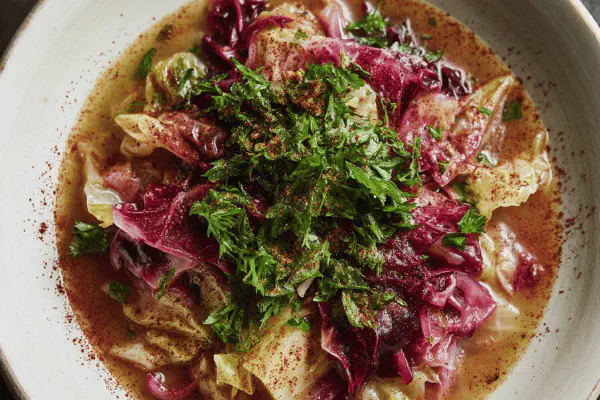Roasted Creamy Tomato Soup

By Emma
Certified Culinary Professional
Ingredients
- 2 1/2 pounds ripe Roma tomatoes, stems removed, quartered
- 1 medium yellow onion, roughly chopped
- 2 medium carrots, peeled and chopped
- 4 cloves garlic, smashed
- 1 tablespoon fresh flat-leaf parsley, roughly chopped
- 2 tablespoons extra virgin olive oil
- 1 teaspoon sea salt
- 1/2 teaspoon ground black pepper
- 1 teaspoon Italian seasoning
- 4 cups low sodium vegetable broth
- 1/4 cup fresh basil leaves, loosely packed
- 1/3 cup half and half or heavy cream
- Optional twist: pinch of smoked paprika added before roasting
About the ingredients
Method
- Start by preheating oven to 360 degrees Fahrenheit for a slightly faster roast; helps color without drying.
- Grab tomatoes, trim off the woody stems, then quarter. Press gently between fingers to remove most pulpy seeds—not a mess, just majority gone to avoid bitterness.
- In large bowl, combine quartered tomatoes, onion chunks, chopped carrots, smashed garlic cloves, parsley leaves, olive oil, sea salt, pepper, Italian seasoning, and a pinch of smoked paprika if using. Toss thoroughly to coat everything evenly.
- Spread the mixture out on a large rimmed baking sheet in a single layer. Crowding? Avoid. Crowding steals roasting magic.
- Roast about 42 minutes, stirring or turning once halfway through. Look for edges caramelizing but not burning. Garlic should smell sweet and mellow, carrots soften but hold shape.
- Dump entire pan with all juices into a large pot or Dutch oven. Add vegetable broth and fresh basil leaves—freshness cuts richness.
- Use immersion blender here to pulse blend. Don't commit to full smoothness unless you want a very fine texture. Leaving some chunk adds rustic mouthfeel.
- Simmer gently over low heat for 28 minutes, bubbles sparingly breaking surface. Stir occasionally to catch anything sticking. The longer simmer boosts flavor meld but watch plants simmer intensely.
- Take off heat. Stir in cream, watching texture go richer and color brighten slightly. Blend again if preferred smoother, otherwise leave slightly textured.
- Taste and adjust salt or pepper now. Sometimes an extra splash broth or pinch sugar balances acidity from tomatoes.
- Serve hot. Garnish with more fresh basil, a drizzle of olive oil, or crunchy toasted croutons for textural contrast.
- If low dairy tolerance, can swap cream for coconut cream or a dollop of plain yogurt stirred in after off heat.
- Freeze leftovers easily; reheat slowly on stovetop adding splash broth to loosen if thickened too much.
Cooking tips
Chef's notes
- 💡 Oven temp higher than usual, 360°F not 350. Gets tomatoes caramelizing without drying too fast. Watch edges. Not black but golden crisp spots. Garlic cloves soften, sweet smell is key. Carrots soften yet still hold shape. Don’t crowd the pan. Single layer only. Crowding traps moisture, steam kills roast flavor. Toss well in olive oil and seasonings. Even coating. Roasting deeper flavor than boiling raw tomatoes. Poke tomatoes gently, fewer seeds keep bitterness low — small seed pockets burn, big deal in taste. When stirring halfway, flip carefully but quick. Keep skin intact mostly, crackle surface, that’s the sugar browning sound. Smoked paprika optional. Adds earth but not smoky overkill.
- 💡 Blend texture control is everything. For chunky soup pulse once or twice with immersion blender. Smaller chunks give rustic feel. Full puree loses some character but goes velvet smooth. After blending, gentle simmer melds flavors. Don’t boil vigorously. Basil aroma fades fast with heat. Toss basil leaves in now, cook low and slow for freshness without bitterness. Cream goes off heat or very low heat only. Too hot and cream splits, grainy texture. Add cream in slow drizzle, stir slowly to bring richness and smooth finish. Taste before adding salt. Factor broth saltiness, acidic tomatoes sometimes need sugar pinch. Sugar tempers sourness well but too much masks tomato essence.
- 💡 Ingredient swaps common. Half and half, heavy cream, or silken tofu for non-dairy. Coconut cream thick but changes flavor profile. Parsley adds brightness when roasting, fresh is best. Dried herbs mess flavor balance. Broth low sodium preferred. Vegetable broth base but chicken broth can work if depth wanted. Carrots size matters. Baby carrots cook unevenly—chop large carrots in bigger pieces to keep texture. Garlic whole cloves milder roasted; chopped garlic browns faster, stronger aroma. If seeds not removed well, soup can get watery and slightly bitter. Better seed removal saves overall body. Baking sheet rimmed edges help turn veggies without spill.
- 💡 Watch simmer carefully. Gentle bubbling with occasional small bursts, not rolling boil. Vigorous bubbles shake basil leaves apart, aroma dissipates fast. Slow simmer lets flavors deepen while keeping herb freshness alive. Leftover soup thickens in fridge. Reheat slowly, add splash broth if too stiff. Store covered fridge up to three days or freeze for longer. Reheat stirring to reincorporate any cream separation. Roast tomatoes smell distinct, a faint crackle sound happens mid-roast as sugars caramelize—listen closely. Texture after cream addition changes, richer feel coats spoon better. If soup too acidic after cream, splash more broth or pinch sugar. Test often. Final garnish fresh basil, drizzle olive oil, toasted croutons for textural contrast.
- 💡 Avoid crowding pan at all costs. Roasting thrives on air circulation. Crowding causes steaming, dull flavors, soggy skins. Quarter tomatoes evenly, remove tough stems. Seeds removal is hassle but worth it for flavor concentration. Use rimmed baking sheet, spread ingredients out flat. Turn halfway roasting, look for caramelized edges — small splits in skin show sugar browning. Avoid blackened burnt spots, adjust oven time if needed. Garlic aroma will shift from sharp to mellow. Carrot texture gives body, don’t over-soften or soup becomes bland. When blending, pulse, test, then blend more if needed. Cream addition must be slow, off or very low heat to avoid curdling. Taste, adjust salt but hold back salt too much at start. Season after cream is in.
Common questions
How do I keep soup from being bitter?
Trim seeds thoroughly. Seeds burn easily, bitter taste. Also, don’t overdo garlic chopping. Whole cloves, milder after roasting. Watch roast temp, too hot can scorch sugars in tomato. Avoid crowding pan, moisture causes soggy, off flavor too.
Can I use canned tomatoes?
Can, yes, but change texture. Roasting fresh adds caramelization flavor missing in canned. If using canned, roast dry for 15 minutes to get some roast notes. Skip smoked paprika if canned since flavor differs. Simmer time less to avoid bleachy taste from canned acid.
Soup too acidic, how to fix?
Add pinch of sugar or splash more broth slowly. Cream changes acidity perception but sometimes not enough. Avoid adding too much salt thinking it balances acid, can make bitter worse. Slow simmer helps mellow acid, but taste throughout cooking is key.
How to store leftovers safely?
Chill soup covered quickly. Keeps fridge fresh 2 to 3 days tops. Freeze in portioned containers. Reheat slow stove, add splash broth to loosen thickened soup. Stir often to blend cream if separated. Avoid microwave reheating if can, often uneven heating breaks cream texture.



